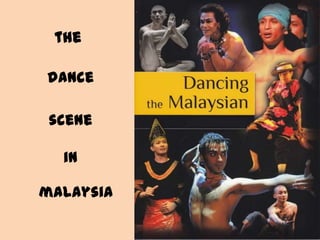Dance scene in malaysia
- 1. the dance scene in malaysia
- 4. Malay traditional dance *Malaysiaâs most superb dance form is known to be the Candle Dance *Many of the dance forms have been originated from martial arts or theatrical forms, like Silat
- 6. And it still liked and performed all over this country
- 8. Traditional Chinese Dance dances were most likely performed by common people groups
- 10. involved dancers locking arms, stamping their feet, and participating in other sounds and movement accompanied by musical instruments
- 11. involved dancers locking arms, stamping their feet, and participating in other sounds and movement accompanied by musical instruments Performed to public to maintain identity
- 13. Traditional Indian Dance dance is a form of worship and an expression of the human emotion.
- 14. *The presiding deity of Dance is Nataraja- Shiva. The main classical dance forms are Bharatanatyam, Kuchipudi, Odissi, Manipuri,Kathakal i and Kathak
- 16. modern dance
- 17. modern dance
- 18. physically difficult dance forms
- 19. physically difficult dance forms
- 20. physically difficult dance forms
- 29. As breakdancing became more and more popular, more âcrewsâ started coming up
- 33. Many competition to support these crews
- 36. What dancer always think ?
- 37. What dancer always think ?
- 38. Conclusio n
- 39. Conclusio n
- 40. Conclusio n
- 41. Conclusio n
- 42. reference
- 43. reference 1) Natalie Tan Jo Leen, We dance For Peace, retrieved on 3 August 2012 from http://wedanceforpeace.wordpress.com/v 2) Indian dance, Dance Malaysia, Retrieved on 4 August 2012 from http://www.dancemalaysia.com/Dance/Traditional/Other_Dances/Indian_Da nce/indian_dance.htm 3) TS Beng (2012), The Lion Dances to the Fore: Articulating Chinese Identities in Penang and Medan, pg. 63 4) Showdown 2012 FAQ (2012), pg. 2, Retrieved on 4 August 2012 from http://apps.8tv.com.my/showdown/2012/download/SD2012-FAQ.pdf











































